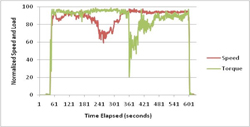Estimating Emissions from Sources of Air Pollution
6.3 Estimating Emissions from Off-Road Mobile Sources
6.3.7 Determining Activity: Duty Cycles or Load Factors of Different Sources
With all fuel-operated equipment, but especially diesel, the emission rate of the engine is strongly dependent on the load of the engine. However, in most equipment operation, the load is a function of the task and varies throughout the period of operation. For example, a tractor drives to the rock pile at a steady engine load, then lifts the material, causing a spike in the load on the engine, then moves the heavy material to a different location with a steady but higher engine load rate (figure 6.3.7-1). The amount of time spent at each engine load is dependent upon how far the rock pile is from the truck and how fast the operator works. These are extremely variable factors that change from job to job. However, an attempt at trying to identify the ‘average’ load cycle should be taken into account because not accounting for this variability can underestimate emissions significantly.
The EPA and ARB has observed and developed many duty cycles that mimic the real world operation of various types of off-road equipment. These patterns are similar to the velocity trace of an on-road vehicle operating on various types of roadways. The operating profile is very important because engine load is highly dependent upon emission rates. Also, some control equipment can only be effective with certain operating cycles. EPA had developed many operating cycles based on observed in use operation in the US (http://www.epa.gov/otaq/regs/non-road/equip-hd/cycles/nrcycles.htm). Figure 6.3.7-2 illustrates the operating pattern of an agricultural tractor under typical operation, showing a period of relatively steady state operation followed by a period of transient operation. These patterns are not the same as the patterns used to certify or measure emissions. However, these patterns are used in determining what the real-world operation looks like and to determine the load factor in estimating overall emissions. There are now relatively easy and inexpensive ways of instrumenting pieces of equipment to gather information on their load cycle under normal operation. This has been done in the US for various types of construction equipment, as well as for recreational motorcraft. This data collection should be at a high temporal resolution to capture the variations in engine conditions. After many samples and seconds are collected, there are several ways to aggregate the data together into the overall ‘typical’ load cycle for various activities Then, the emissions can either be predicted through calculations or measured in the field or laboratory on this ‘typical’ load cycle. Caution should be used in applying these duty cycles because these operations are highly variable depending upon a number of factors and this should be taken into account when trying to define a ‘typical’cycle for any operation or situation.
6.3.7-2 Example of the Operating Pattern and Load Profile of an Agricultural Tractor

